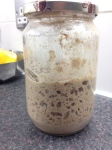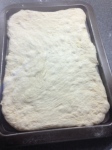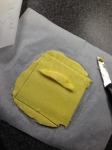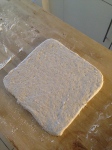I’ve been baking with my sourdough starter for quite a while now. It really is that easy to get a starter going. Ι got mine going initially on organic and unbleached plain white (wheat) flour and filtered water, and once I got it going, it was subsequently based on equal measures of organic stoneground rye flour and filtered water that I weighted on kitchen scales (in grams). There is a reason I keep mentioning ‘organic’ flours and ‘filtered’ water, and I’ll elaborate further down. Now if you want to go straight to the steps, scroll all the way down, otherwise you might want to get the low-down first. An early shout-out to Ed and Marieke – the Weekend Bakery team – for their amazing website which contains the recipe I’ve based my sourdough starter.
Some general background info to put the whole thing into context:
Baking breads requires the use of a leavening agent to get the dough to rise. Doughs rise due to two processes: firstly, due to the release of gases from the interaction of leavening agents with the other ingredients in the dough – in this case, the gases get trapped in, and expand, the dough surrounding these – and, secondly, due to the hydration in the dough turning to steam and seeking to escape from the surrounding dough. Both these processes interact with the dough to alter its taste and texture. For instance, gases impart aromas to the dough they press against while the heat and the steam cook the dough and consequently we get those holes in the crumb – in the case of high hydration sourdough bread varieties, and other high hydration breads such as ciabatta and focaccia, we see those large bubbles due to the increased aeration.
Leavening agents used in baking are things such as bicarbonate of soda (‘bicarb’), or/and buttermilk as is the case with Irish Soda bread. Bicarb is used a lot in cake baking, and you don’t really want to get an elastic bread-like consistency and texture with cakes, hence why the cake mix/batter is not ‘doughy’. A cake mix is more runny so it’ll be like a batter that you don’t want to be mixing too much otherwise you’d be strengthening the gluten bonds within the flour and getting it too elasticky. You don’t want this with sponge cakes as you want these to have a different texture nor do you want it with biscuits which you’d want to snap rather than chew. Coming back to bread and yeasted-dough product baking, the most frequently used leavening agents are either baker’s yeast (i.e., the fresh grey-brown plasticine-like product — I get mine in 50g chunks from my local supermarket) or dried yeast granules sold in sachets or small tins. In relation to the dried yeast granules, there you can get ‘fast action’ or conventional granules. The former can be added straight to the flour and the other ingredients while the latter has to be ‘activated’ in some liquid, and, in some cases depending on the recipe, with some flour added along side it and the liquid. I rarely use dry yeast as I usually bake sourdough bread products (pizza, garlic bread, savoury or sweet buns etc), or use fresh yeast in things such as tsoureki or my Christmas Stollen (recipe soon to follow). Very occasionally I make Lardy Cake in which I use a sourdough starter base and a tiny amount of fast action dry yeast granules (recipe soon to follow).
Baker’s yeast (fresh yeast) and dry yeast granules all contain various types of yeast micro-organisms that thrive in a moist warm environment that is rich in carbohydrates for them to feast on. Hydrated flour – i.e., dough – provides such an environment. These yeast micro-organisms multiply and produce gases as a by-product of feasting on the carbs. These gases get trapped in the elasticity of the dough which causes it to rise. Also, as alluded to briefly above, the use of wheat and other gluten-containing flours means that by kneading the dough, the gluten starts developing into strands that bind with one another and make the dough more elastic bringing it firmly into the bread zone (rather than the cake or shortcrust/biscuity zone). This gluten development process interacts with the gases and heat produced by the leavening agent — remember the microorganisms’ carb fest — and the heat produced during the kneading stage to cause the dough to rise as the gas gets trapped amongst the dough’s elasticity. This is the ‘proving’ stage we read about in bread and yeasted dough product recipes though in reality what is being ‘proved’ isn’t the dough per se but whether the yeast actually works. Bread recipes usually call for one or two ‘proves’. I usually rely on two proving stages for most of my bread and yeasted dough product baking (e.g., my sourdough pizzas, pitta breads, ciapatta, focaccia, garlic breads, sweet buns, savoury buns, cinnamon rolls, tsoureki, etc).
Now the difference with a sourdough starter is that there is no use of a ready-prepared/made leavening agent — the sourdough starter, once successful, becomes your leavening agent. So no need for bicarb, baker’s yeast, dry yeast granules, etc to get dough to rise. What I use to get a sourdough starter is two ingredients: plain flour and water. The kit I need is a jar and a knife/spoon/fork to stir. The conditions I need is the warmth and darkness of an airing cupboard. The other resource I need is time, by which I mean mere patience rather than effort. As I said, I use equal amounts/measures (in weight) of plain unbleached flour and filtered water. I use tap water that I pass through a water filter for reasons I’ll explain below. Microorganisms exist all around us; on our hands, in the air, on surfaces, and so on. Such microorganisms are viruses, natural yeasts, and bacteria. Our food we eat, the water we drink, things we touch, and so on, contain, or are surrounded by, them. Functioning immune systems habitually fend these off or aren’t that much compromised by these. The point about trying to get a sourdough starter going is to harness those types of bacteria and natural yeasts, from those which surround us, that are likely to produce tangy, sour-ish, starters, rather than the types that spoil your starter. The latter can happen too and the smell and hue of it would usually give it away. Also, this is the reason I use organic and not overly processed flours in the hope that there is a greater chance for microorganisms to have survived on the grain and in the flour free from pesticides and/or from bleaching. Also, this is the reason I filter my water so that there are fewer chemicals in it that are likely to kill off those microorganisms.
Once the sourdough starter is ready, I take the necessary quantity of starter and mix this with flour and water to make the dough I use for my sourdough pizza, sourdough croissants, and for other baked goods. It is this starter – rich in bacteria and natural wild yeasts – that acts as the leavening agent in my doughs. It does this in the following way: the microorganisms in my starter consume the carbs in the flour and produce gases that cause a dough to rise/expand. The long retarded ‘proving’ that I use – namely, 48 hours refrigerated second prove for my sourdough pizza dough – means that the leavening process is protracted, and this drawn-out infusion of the dough with the gases imparts the aroma of the gases into the dough, hence the sourness and tang that one gets with good sourdough. Now, different microorganisms produce gases that impart different aromas into the dough. For instance, it seems to me that the yeasts I manage to catch are responsible for the fruitier, more sour scent while bacteria such as lactobacilli, which a sourdough starter may also contain, seem responsible for the cheesy tang I get particularly when I’ve not fed by sourdough starter regularly. More about that below.
What is more, the gassy environment combined with the depletion of carbs for the microorganisms can lead to a noxious environment that could become lethal for the microorganisms in the starter, hence the need to replenish the starter regularly (I’ll refer to this as ‘feeding’ the starter). Think about all these microorganisms competing for food. Bacteria tend to reproduce faster and thus outcompete the yeast microorganisms in the starter. This means that if the bacteria side becomes more dominant, the starter, and the baked goods you make, are likely to lack the fuller flavour/aroma profile of a more balanced starter. Again, a further reason to feed regularly to give those yeasts a better change which all improves the taste of your final products.
Now, ‘feeding’ is also a simple process. I tend to use my sourdough starter twice a week hence why I keep it in an open jar on my work top and feed daily. This is far from too fiddly or arduous as it might sound. It basically involves me throwing away almost all of it, leaving a tablespoon of the starter at the bottom of the jar, to which I then add 50g of stoneground rye flour and 50g of filtered water — I weigh these with a digital scale — which I then mix very well with a butter knife, and leave on the work top without the lid on. If I plan to use my sourdough starter within the next 24 hour or so, I leave it on the work top. till the moment I use it. If I plan to use it a few days or a week down the line, I let it rise first and then seal it with the lid and refrigerate until the day before I’m to use it. I then bring it to room temperature, throw all but a tablespoon away, feed it as per the above, and use it whenever it has risen. This could be anything from 3-24 hours depending on weather conditions and the strength of the starter. I’ve named the article ‘Hackney sourdough starter’ as it it’s likely to contain wild yeasts from the part of London it was ‘conceived’.
Now the precise steps to making a sourdough starter
- Add 50g white unbleached plain wheat flour and 50g water to a jar (yes, weigh the water), stir well and leave (without the lid) in a warm dark airing cupboard (but away from direct contact or too close to a hot boiler);
- now every 24 hours for the next 3 or 4 days take the jar out of the cupboard, stir the thick batter-like mix, and return to the airing cupboard to rest (again, without the lid);
- by Day 3 or 4 there should be bubbles in the batter mix – if so, congrats! There is life in your batter, and it’s producing these gases;
- this is the stage where you take your jar out of the cupboard, throw all but a tablespoon of the starter away, mix in 80g rye flour and 80g of filtered water, mix it all very well, and leave for anything between 3 to 24 hours to now use in your bread-baking recipes. It really does depend on how warm the enviroment is and how strong the starter is (i.e., how high the microorganism count in the starter) that determines how fast it’ll rise.
As I usually make pizza dough regularly for myself – and given that each batch of pizza dough is about 500g flour to which I add 150g of sourdough starter – I tend not to need more than 300g of active sourdough starter weekly unless there’s some extra baking going on that week. This means that I tend to feed my starter daily but only replenish it with about 60g of flour each time as to avoid wasting too much flour.
Hope you succeed in getting your sourdough starter going and that you find it as rewarding as I have using mine.
Great sites for more info about sourdough:
http://sourdough.com
http://www.thefreshloaf.com
http://prozymi.blogspot.co.uk (Greek)
Photos to be posted soon.




































































